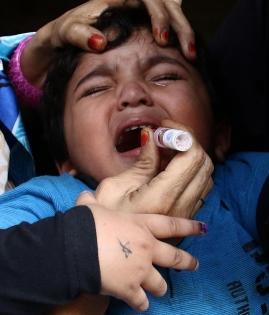Poliovirus detected in sewage samples from 42 sites across Pakistan
By IANS | Updated: August 13, 2025 14:00 IST2025-08-13T13:50:33+5:302025-08-13T14:00:05+5:30
Islamabad, Aug 13 Wild poliovirus type 1 (WPV1) has been detected in sewage samples from 42 sites across ...

Poliovirus detected in sewage samples from 42 sites across Pakistan
Islamabad, Aug 13 Wild poliovirus type 1 (WPV1) has been detected in sewage samples from 42 sites across Pakistan, health authorities said.
A total of 127 sewage samples were collected from 87 districts during July, according to testing by the Regional Reference Laboratory for Polio Eradication at the National Institute of Health in Islamabad on Tuesday, Xinhua News Agency reported.
Of these, 75 samples tested negative, 42 were positive, and 10 are still under process.
Earlier in July, three new polio cases were reported in Pakistan, raising the total number of cases in the country in 2025 to 17. Two new polio cases have been reported in Khyber Pakhtunkhwa and one in Sindh.
According to the Regional Reference Laboratory for Polio Eradication at the National Institute of Health (NIH) in Islamabad, cases have been reported in Khyber Pakhtunkhwa's North Waziristan and Lakki Marwat and Sindh's Umerkot, Pakistan-based The News International reported.
The new cases include a 15-month-old girl from Union Council (UC) Takhtikhel in Lakki Marwat, a six-month-old girl from UC Mir Ali-3 in North Waziristan, and a five-year-old boy from UC Chajro in Umerkot.
According to the statement, the total number of polio cases in Pakistan in 2025 has increased to 17, including 10 from Khyber Pakhtunkhwa, five from Sindh and one each from Punjab and Pakistan-occupied Gilgit-Baltistan.
Polio is a highly infectious viral disease that largely affects children aged below five years, according to the World Health Organization (WHO). There is no cure for polio; however, it can only be prevented by immunisation. The polio vaccine, given multiple times, can protect a child for life. Initial symptoms of polio are fever, fatigue, headache, vomiting, stiffness of the neck and pain in the limbs. One in 200 infections leads to irreversible paralysis (usually in the legs). Among those paralysed, 5–10 per cent die when their breathing muscles become immobilised.
Disclaimer: This post has been auto-published from an agency feed without any modifications to the text and has not been reviewed by an editor
Open in app